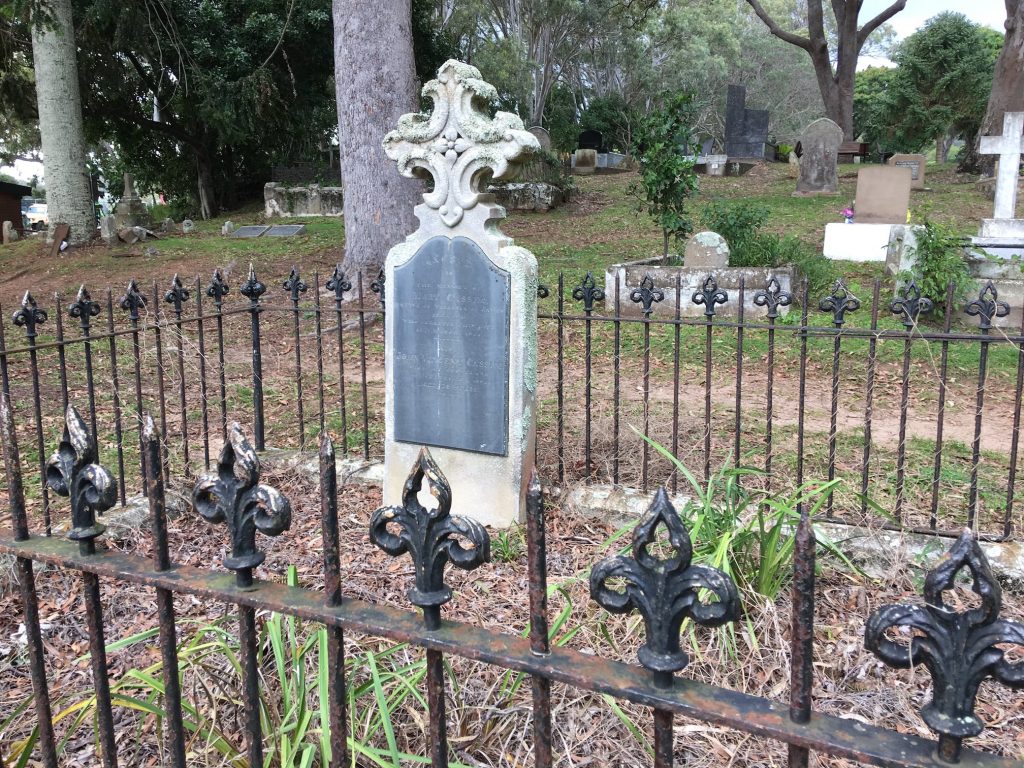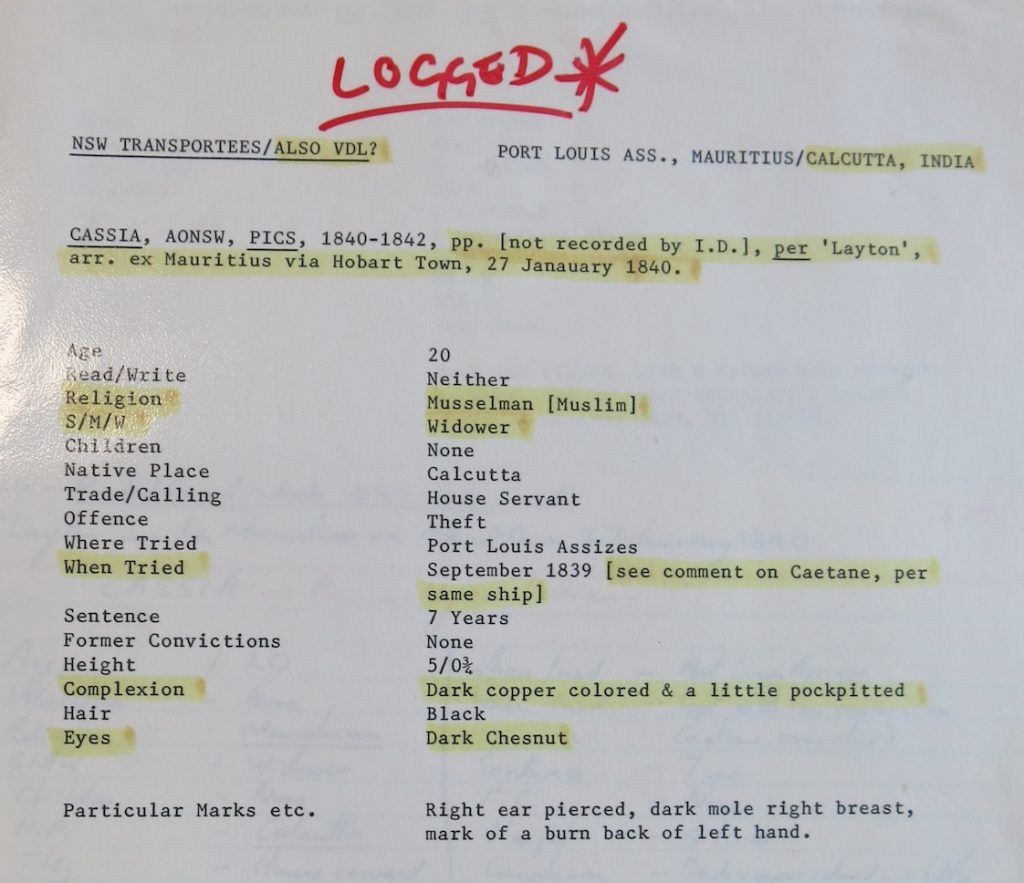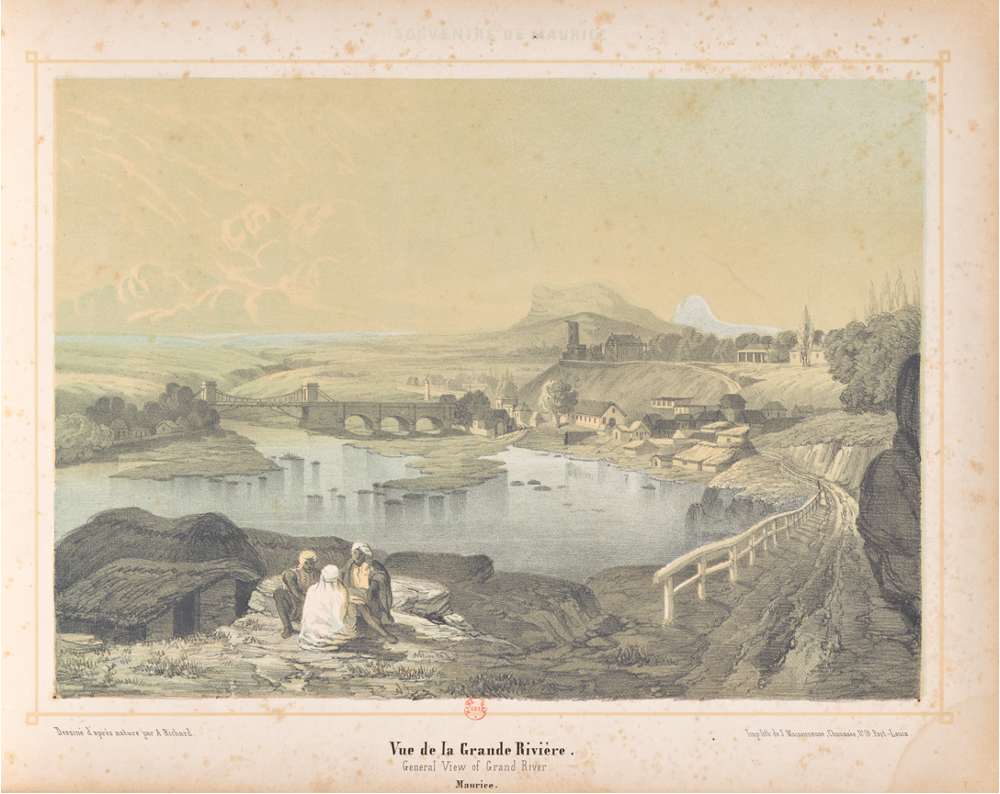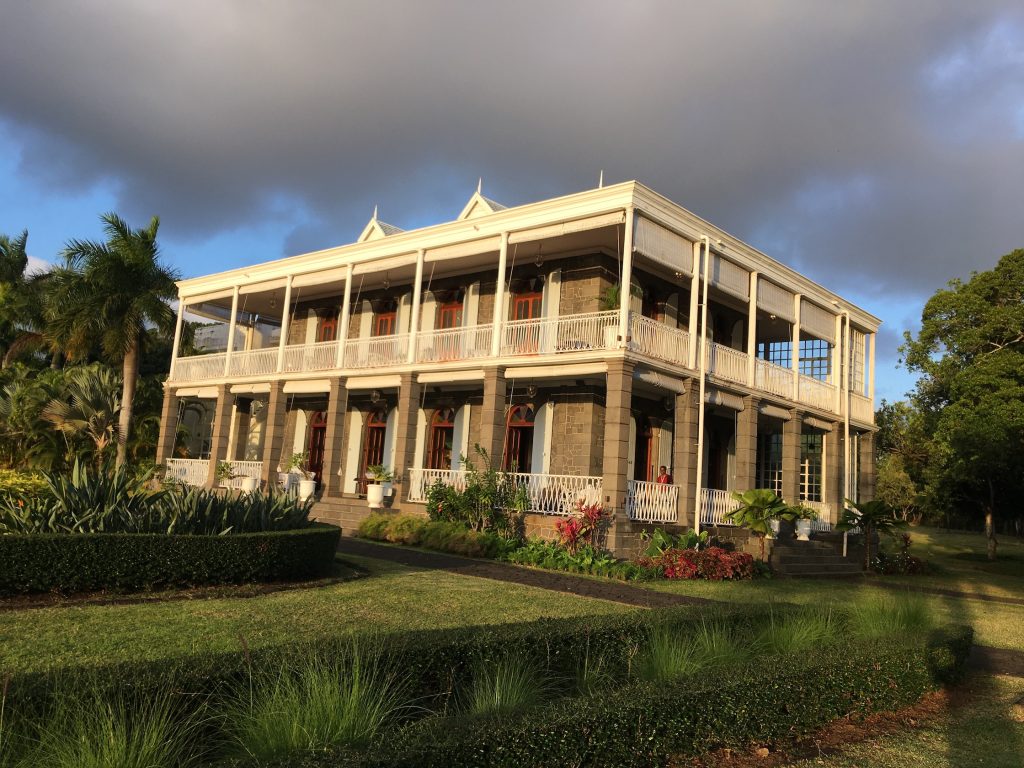One of the graves that can be found in Minjeribah (North Stradbroke Island)’s Dunwich Cemetery in the Australian state of Queensland bears the name of John Vincent Cassim and his wife Mary (Figure 1). I recently returned to the grave site with my friend and fellow historian Tamsin O’Connor, who is an expert on the convict history of Moreton Bay. This blog is partly based on our conversations as we toured the island and reflected on the meanings attached to the extraordinary subaltern lives of John and Mary Cassim.

Figure 1: Mary and John Vincent Cassim, Dunwich Cemetery, Minjeribah. Photo: Clare Anderson, 2023.
John and Mary Cassim are fascinating figures in the connected histories of the British Empire, spanning Britain, Ireland, South Asia, the Indian Ocean, and Australia. A consideration of their lives opens out to view histories of migration, colonial labour regimes, relationships between workers, and settler colonialism. It also allows insights into processes of cultural assimilation, difference and distinction, and the role of religion in producing ‘respectable’ colonial citizens in ‘frontier’ societies in the middle of the 19th century.
I first learned about ‘Cassim’ from the work of my PhD supervisor, the late Ian Duffield ‘Cassia’ [sic] was included in Ian’s meticulous research on African and Asian transportation to the Australian colonies, conducted in the 1980s, well before the digitisation of various archives (Figure 2). Drawn from the convict indents (ship lists) and individual convict records of Van Diemen’s Land (now, Tasmania), Ian gave me this convict list when I went to work in the National Archives of Mauritius as a PhD student in 1994. He asked whether I might be able to find out more about Cassim – and the other Mauritians that he had located in the Australian records.

Figure 2: Cassia [sic], Ian Duffield’s typescript record.
At that time, I was researching the history of the Indian penal settlement in Mauritius, which transferred from French to British Crown rule at the end of the Napoleonic Wars in 1815. A chance find in Britain’s Colonial Office papers (held in what was then called the Public Record Office and is now called The National Archives) had revealed that the East India Company transported almost 1,500 convicts to Mauritius from the Bengal and Bombay presidencies during the period 1815-37. I learned a great deal about this unexplored story of convict transportation from these papers, and from later research in the India Office records (now kept in the British Library) and the rich collections held in Mauritius. The penal settlement remained active until 1853 (Figure 3).

Figure 3: A. Richard, View of Grand River, 1853. Source: National Library of France.
Penal transportation to Mauritius co-existed with the enslavement of Africans and locally born Creoles (a word that in the Indian Ocean context implied blended African/ European heritage), and with the importation of indentured labour from India and China. This created a complex web of social, cultural and economic entanglements, though the hundreds of thousands of enslaved and indentured labourers are much better represented in the historical literature and popular history than the relatively small number of convicts sent to the island.

Figure 4: Bel Ombre, Mauritius. Photo: Clare Anderson, 2022.
During the early years, a few of the Indian convicts were put to work alongside enslaved Africans on sugar plantations (including the Bel Ombre estate, made famous by British abolitionists [Figure 4]) and used in experimental silk production. However, most convicts then and later were deployed on public works projects, constructing the roads and bridges that enabled the expansion of the sugar industry, and which still criss-cross the island today.
Casssim’s trial reveals the extent to which the lives of Mauritius’ cosmopolitan populations were intertwined. Cassim was in the service of one Edouard Arbuthnot, a merchant who lived in Port Louis. The precise mechanisms that placed Cassim in Arbuthnot’s household are unclear, but despite other recorded discrepancies, the Australian records record his native place as Calcutta. He may have come to the Island in private service rather than as an indentured labourer or as a convict under sentence. Regardless, his apparent status as a trusted servant would prove significant to the trajectory of his life course. In August 1839, in the period immediately following the abolition of enslavement and its successor system of apprenticeship, he was arrested with a man called Ruffee. They were implicated in the theft of a quantity of silverware, including a canteen of cutlery, from the residence of Cassim’s master. Ruffe was described by the public prosecutor as an ‘ex-convict’ who we also learn had been transported to Mauritius in 1828 for ‘beating a man so as to cause his death.’ Interestingly he was in the employment of Colonel William Staveley, formerly the head of the convict department.
Another convict named Assene, also in the service of Colonel Staveley, had told his master that Ruffee had visited the convict barracks, then located at a place called Parc à Boulets, to sell the stolen goods. Some of them were in the possession of yet another convict, a man called Gangoula. It was alleged that Cassim had stolen the goods and given them to Ruffee to sell, for the two men had been heard talking about it. This is a detail that proves crucial in terms of subsequent sentencing. This mixing of convicts and ex-convicts with the non-convict Indian population was undesirable from a colonial perspective – but it was far from unusual. The British took steps to segregate free and convict workers living at Parc à Boulets, to try to prevent relationships between them, but it was a futile effort given, their shared experience of everyday life.
For instance, the civil status of Indian convicts was tested at Cassim and Ruffee’s trial, when the men’s defence lawyer put forward a motion that – as a convict deprived of his civil rights – Assene could not be called as a witness. The court dismissed the motion. It is also notable that whilst Cassim was unable to sign his name (and in fact used an ‘X’ for the rest of his life in Australia), both Ruffee and the convict witness Gangoula (perhaps surprisingly) signed the court papers. What is most important to us here is that Cassim and Ruffee were both found guilty. Ruffee was sentenced to 7 years’ forced labour in Mauritius for his role as a receiver, and Cassim, who had been found guilty of the actual theft from his own master’s house, faced a sentence of transportation for the same period.
Presumably, Ruffee joined the prison labour gang then working on the construction of the Port Louis Citadel. Meanwhile, Cassim was transported to Van Diemen’s Land, on the Waterwitch, but as part of a general transfer of African and Asian convicts (who had suffered immensely from the cold), he was almost immediately sent on to Sydney for transfer to warmer climes. Accordingly, he was lodged in Hyde Park Barracks before being shipped to the northern station at Moreton Bay (modern Brisbane), where he arrived in April 1840. From there, he was dispatched to the Limestone Hills (modern Ipswich), where 59 convicts were employed looking after the vast flocks of government livestock.
The story will continue in a second blog ….
Clare Anderson and Tamsin O’Connor
Further reading:
- Chris Hill, ‘Cassim’s Wife’, in Roberta Bonnin, ed., Women of the Redlands: stories by women of the Redlands community (Redlands QLD: Redland Shire County Library, 1998), 2-5.
- Patrick J. Tynan, Johnny Cassim: Coolie – Convict – Catechumen – Colonial Entrepreneur (1814-1884) (Toowoomba QLD: Church Archivists’ Press, 2006).
- Clare Anderson, Subaltern Lives, Biographies of Colonialism in the Indian Ocean World, 1790-1920 (Cambridge: Cambridge University Press, 2012), chapter 3.
- ‘The Convicts from Mauritius’, Moreton Bay and More Blog.
We thank the Redlands Museum for supporting this research.